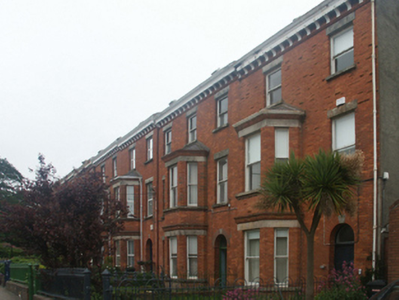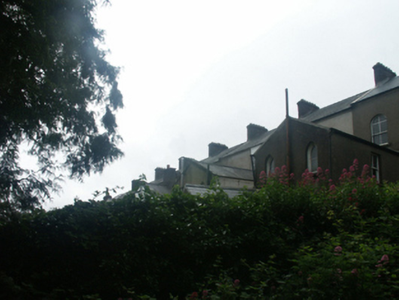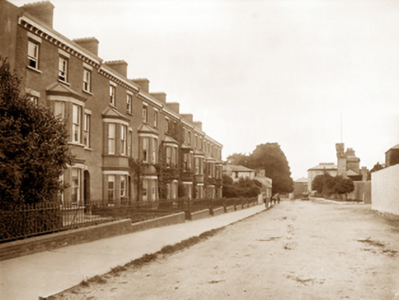Survey Data
Reg No
15500019
Rating
Regional
Categories of Special Interest
Architectural, Artistic
Original Use
House
In Use As
House
Date
1890 - 1895
Coordinates
304370, 122279
Date Recorded
23/06/2005
Date Updated
--/--/--
Description
Terraced two-bay three-storey townhouse, built 1892, on a rectangular plan. Occupied, 1901; 1911. Refenestrated, ----. One of a terrace of eight. Pitched slate roof with clay ridge tiles, coping to gables with red brick Running bond chimney stacks to apexes having corbelled stepped capping supporting yellow terracotta pots, and cast-iron rainwater goods on decorative timber eaves boards on timber consoles on terracotta stringcourse. Red brick Running bond wall to front (south) elevation on rendered chamfered plinth; rendered surface finish (remainder). Round-headed door opening (east) with cut-granite step threshold, and red brick voussoirs centred on cut-granite keystone framing timber panelled door having overlight. Square-headed window openings with cut-granite sills, and cut-granite lintels framing replacement uPVC casement windows replacing one-over-one timber sash windows. Set back from line of street with cast-iron colonette piers to perimeter having polygonal capping supporting crocketed cast-iron gate.
Appraisal
A townhouse erected by Mary O'Connor (1837-1927) as one of a terrace of eight houses (including 15500016 - 15500018; 15500020 - 15500023) representing an important component of the late nineteenth-century domestic built heritage of Wexford with the architectural value of the composition confirmed by such attributes as the compact rectilinear plan form; the construction in a vibrant red brick with silver-grey granite dressings producing a two-tone palette the diminishing in scale of the openings on each floor producing a graduated visual impression with the principal "apartments" defined by a polygonal bay window; and the timber work embellishing the roofline. Having been well maintained, the elementary form and massing survive intact together with substantial quantities of the original fabric, both to the exterior and to the interior where encaustic tile work; contemporary joinery; restrained chimneypieces; and plasterwork refinements, all highlight the artistic potential of the composition: however, the introduction of replacement fittings to most of the openings has not had a beneficial impact on the character or integrity of a townhouse forming part of a self-contained ensemble making a pleasing visual statement in Spa Well Road. NOTE: Occupied (1901) by William Dundas (----), 'Lieutenant Royal Irish Active List' (NA 1901); and (1911) by Richard O'Toole (----), 'Railway Agent' (NA 1911).







